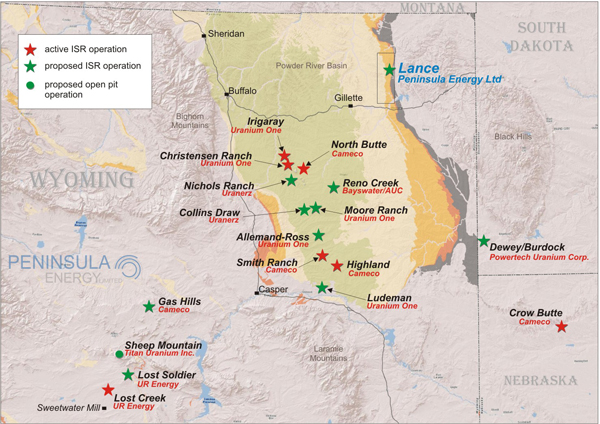Published on Tuesday May 13 2014 (AEST)

The last year construction began on a nuclear power plant in the United States was 1977, but that is about to change.
The Department of Energy announced in February that it is backing the construction of two new nuclear power plants, and TREC,
a Woodard & Curran company, is working on a major uranium mining
project to provide the fuel that these and other plants will need. After
four years, the Nuclear Regulatory Commission (NRC) recently gave
initial permitting approval and released the final environmental impact statement for the first phase of the project where TREC will play a leading role.
Strata’s Lance In-Situ Uranium Recovery Projects
in northeastern Wyoming encompass at least 190 combined miles of
uranium mineralization and more than 53 million pounds of triuranium
octoxide compound. TREC is leading the pre-construction activities for
the uranium processing plant under a design/build contract and providing
conceptual designs, detailed engineering design support, procurement,
and construction services.
“Designing the system is an exciting challenge for our team,” said
Brian Pile, a Regional Operations Manager at TREC. “This project is made
even more significant because it will be such an important source of
fuel for clean, low-carbon energy production in the future. We are
committed to the efficient design of a low-impact system that protects
the local ecology and creates long-term benefits for both Strata Energy
and the local economy.”
The TREC team completed each component of the facility design,
including mass balance, piping and instrumentation diagrams, and process
layouts, as well as structural and instrumentation and control
engineering. TREC also managed the laboratory, plumbing, HVAC and
architectural design work for the facilities and generated
specifications for the building, construction, equipment, pumps, tanks,
and process, mechanical, structural, and electrical controls. Woodard & Curran is assisting TREC with the electrical and instrumentation and controls aspects of the project.
Prior to construction, TREC developed performance specifications that
were provided to vendors for pricing and associated structural, safety,
and ventilation designs, which were then incorporated into the facility
design. This approach significantly reduced design costs and will
expedite the building process.
Production at the Lance Projects
The Ross Production Site, the first phase of the Lance Project, is
the area where Strata is currently focusing development and will use
in-situ recovery (ISR) to extract the uranium, rather than an open pit
or underground mine. ISR at the Ross project involves a number of
injection wells that pump a solution of groundwater mixed with oxygen
and sodium bicarbonate (lixiviant)
into the sandstone that holds the uranium. The lixiviant oxidizes and
dissolves the uranium, which is then drawn up by recovery wells. The
solution is pumped to a central processing plant, where the uranium is
extracted through an ion-exchange circuit, elution, precipitation
processes, and drying for an initial annual production rate of 1.2
million pounds of “yellowcake” by 2017. The water used to bring the
dissolved uranium to the processing plant is then re-fortified and
returned to the aquifer in the closed loop process.
The entire wellfield is surrounded by a series of perimeter
monitoring wells to guard against the migration of mining solution
outside of the recovery area. ISR requires minimal surface disturbance,
and the affected area—including the groundwater—is restored when the
mining operation is concluded.
The Ross site will contribute a significant portion of the total
United States production of uranium. According to the U.S. Energy
Information Administration, 2013 domestic uranium production totaled roughly 4.8 million pounds.
Strata is targeting 1.2 million pounds of triuranium octoxide produced
at the Ross site per year through the years 2014 – 2017 and later plans
to increase production to 2.3 million pounds per year.
The
uranium will be extracted through an ion-exchange circuit, elution,
precipitation processes, and drying for an initial annual production
rate of 1.2 Mlbs of “yellowcake” by 2017.
Construction Underway
Ground breaking commenced in October of 2013. Phase I construction
has been completed to the point feasible during the winter months. TREC
and Strata have begun procuring equipment and the pre-engineered steel
buildings to allow for the rapid continuation of construction in the
spring. Strata anticipates that the NRC will issue the Source Material
License in early April 2014, which will allow the construction of the
processing plant and initial wellfields.
“The design/build approach streamlines the process for Strata
Energy,” Pile added. “The project benefits by having one contract and
entity for design, construction, cost, and schedule management. It
really is a true turn-key delivery for the owner, which provides them
with the ability to focus on their core business.”
.
Click Image To Access Uranium Stocks Australia
.





